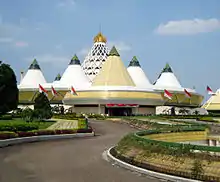Taman Mini Indonesia Indah
Taman Mini "Indonesia Indah" (TMII) (English: "Beautiful Indonesia" Miniature Park) is a culture-based recreational area located in East Jakarta, Indonesia. It is operated by Yayasan Harapan Kita, a foundation established by Siti Hartinah, the first lady during most of the New Order and wife of Suharto, and still run by Suharto's descendants since his death. It has an area of about 100 hectares (250 acres). The park is a synopsis of Indonesian culture, with virtually all aspects of daily life in Indonesia's 26 (in 1975) provinces encapsulated in separate pavilions with the collections of rumah adat as the example of Indonesian vernacular architecture, clothing, dances and traditions are all depicted impeccably. Apart from that, there is a lake with a miniature of the archipelago in the middle of it, cable cars, museums, Keong Emas Imax cinema, a theater called the Theatre of My Homeland (Theater Tanah Airku) and other recreational facilities which make TMII one of the most popular tourist destinations in the city.[1]
 | |
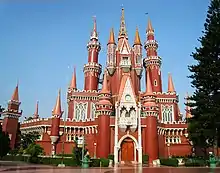 Indonesian Children Castle at TMII | |
| Location | Jakarta Timur, DKI Jakarta, Indonesia |
|---|---|
| Coordinates | 6°18′6″S 106°53′48″E |
| Slogan | Kunjungi Taman Mini, Cintai Indonesia (Visit Taman Mini, Love Indonesia) |
| Owner | Government of Indonesia |
| Operated by | Suharto family through Yayasan Harapan Kita |
| General manager | Tanribali Lamo |
| Opened | 20 April 1975 |
| Attractions | |
| Total | 5 |
| Water rides | 2 |
| Website | www |
| Status | Operating |
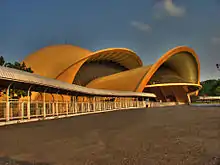
Since 2007 Taman Mini Indonesia Indah launched new logo with branding slogan Pesona Indonesia (Indonesian Charm).
On December 31, 2014 World Peace Committee decided TMII as International Civilization Park and World Peace Theme Park.[2]
History
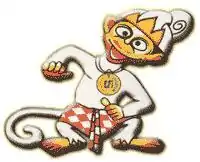
The idea of presenting Indonesia in a small scale was conceived by former Indonesian first lady, Siti Hartinah, better known as Tien Suharto. It came about at a convention on 8 Cendana Street at March 13, 1970. Through this recreational site, she hoped to cultivate national pride in more Indonesian people.[1] A project called "Indonesian Miniature Project" was started by Harapan Kita Foundation in 1972. The concept of this culture-based recreational area was inspired by Indonesia's unparalleled natural riches and local folk diversity.
Characteristics
TMII was originally located on a public area of 145 ha, as farms and fields. Later, the team was able to convert these fields into a suitable location for the construction. The topography of TMII is rather hilly, consistent with what the builders required. The team claimed the advantage of utilizing this uneven terrain was the ability to create interesting and diverse landscapes and enclosures, as well as reflecting the various characteristics of the Indonesian environment.[1]
Parts of TMII
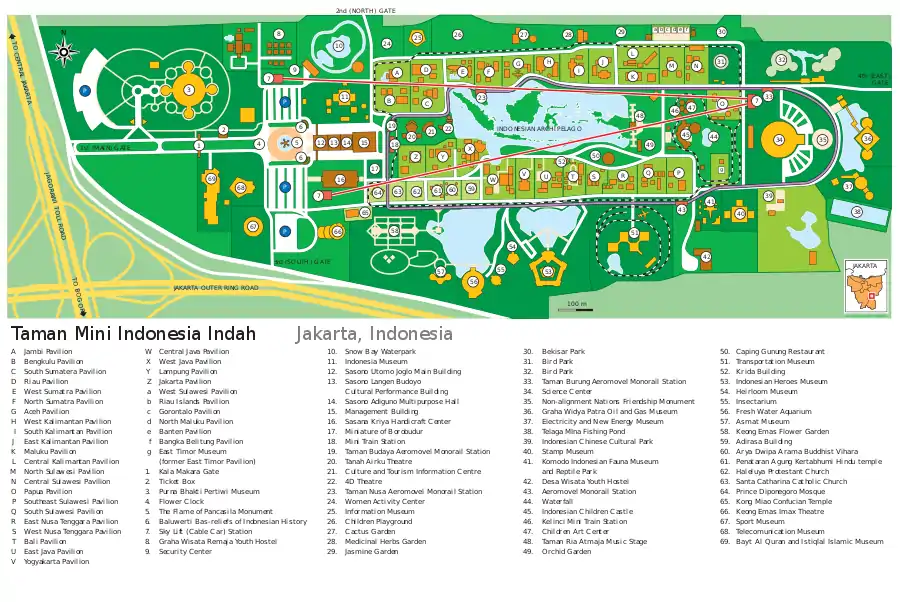
Venues of Indonesian provinces
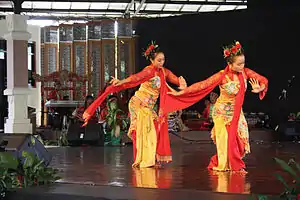
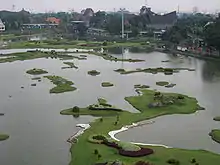

Since each Indonesian province maintains its own unique and distinct cultures, shelters, attire and dialects, TMII built a model of each of the houses from Indonesian provinces. TMII attempted not only to reconstruct the homes of the various provinces, but also to create a realistic model of the environment and shelters of the various people of Indonesia.[3] The venues, which are situated around the main lake in a similar fashion to the different islands of the Indonesian archipelago, are thematically divided into six areas in respect to the main islands of Indonesia; Java, Sumatra, Kalimantan (Borneo), Sulawesi, the Lesser Sunda Islands, Maluku and Papua. Each pavilions featured in typical vernacular Indonesian architecture of each provinces. Examples of Indonesian traditional vernacular houses are: Joglo and Omah Kudus Javanese houses of Central Java and Yogyakarta pavilion; Minang Rumah Gadang of West Sumatra pavilion; Malay houses of Jambi and Riau provinces; Torajan Tongkonan and Bugis house of South Sulawesi pavilion; and Balinese house compound with intricately carved candi bentar split gate and kori agung gate.
It also displays various traditional costumes, wedding costumes, dance costumes, also ethnography artifacts such as weapons and daily tools, models of traditional architecture are in display to describes the way of life of its people. Each provinces pavilions also equipped with small stage, amphitheatre or auditorium for traditional dance performances, traditional music performances or traditional ceremonies that usually held in Sundays. Some of these pavilions also equipped with cafeterias featuring traditional Indonesian cuisines and also souvenir shops offering various handicrafts, T-shirts and souvenirs.
Since 1975 until the 2000s, the original design of TMII consists of a model of the traditional houses (rumah adat) from the 27 provinces of Indonesia, including East Timor. But after the secession of East Timor from Indonesia in 2002, the East Timor pavilion changed its status to become the Museum of East Timor. Since Indonesia now consists of 34 provinces, the new province pavilions of Bangka Belitung, Banten, West Sulawesi, North Maluku, Gorontalo, Riau Islands, and West Papua has been built in northeast part of the park, although the size and area of the newly built pavilions is much smaller than the previously built pavilions.
After the recognition of Indonesian Chinese culture as an integral part of Indonesian culture in 2000, the new Indonesian Chinese pavilion and a Confucian temple was built within the park.
Religious buildings
The religious buildings of several official faiths is meant to showcase the inter-faiths tolerance and religious harmony of Indonesia. The religious buildings are:
- Pangeran Diponegoro Mosque
- Santa Catharina Catholic church
- Haleluya Protestant church
- Penataran Agung Kertabhumi Balinese Hindu temple
- Arya Dwipa Arama Buddhist temple
- Sasana Adirasa Pangeran Samber Nyawa
- Kong Miao Confucian temple
Gardens and parks
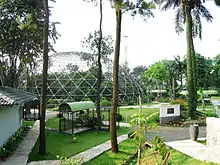
There are about ten gardens spread within TMII complex, but most are located primarily on the north and northeast side of the main lake:
- Orchid Garden
- Medicinal herbs Garden
- Cactus Garden
- Jasmine Garden
- Keong Emas (Golden Snail) Flower Garden
- Taman Ria Atmaja Park, stage and music performances
- Taman Budaya Tionghoa Indonesia, an Indonesian Chinese cultural park (under construction)
Taman Bekisar
Taman Bekisar is park that focus on Galliformes, especially rooster.
Free roaming aviary
- Helmeted guineafowl (Normal and albino individuals)
- Bekisar
- Java Peafowl (One aggressive large male individual may approach and attack visitors)
Individuals aviary
- Silkie
- Bantam chicken (Golden form)
- Ayam Pelung
- Ayam Kedu
- Common pheasant
- Serama
Taman Burung (Bird Park)
Taman Burung is divided into five exhibits: Kubah barat (west dome) which include birds on the Sumatra, Borneo, Java, and lesser Sunda islands, kubah timur (east dome) which include birds from Sulawesi, Maluku Islands, and New Guinea, river exhibits, individual exhibits, and raptor exhibits. The park also own several birds from outside of Indonesia, such as pheasants from China and crowned crane from Africa.
Birds for sale
To avoid overpopulation, the park sells non-endangered birds ranging from the cheap albino pigeons to the fancy blue peafowl.
Photo booths
Free ranging river exhibit
Kubah barat
- Wreathed hornbill
- Oriental pied hornbill
- Greater Bornean crested fireback
- Wrinkled hornbill
- Black hornbill
- Lady Amherst's pheasant
- Rhinoceros hornbill
- Black-winged starling
- White-breasted waterhen
- Bali myna
- Pied stilt
- Black-naped oriole
- Javan pond heron
- Black-headed ibis
- Purple heron
- Lesser whistling duck
- Javan peafowl
- Great argus
- Greater yellownape
- Zebra dove
- Javan myna
- Green junglefowl
- Eastern cattle egret
- Glossy ibis
- Woolly-necked stork
- Black crowned crane
Raptor exhibits
Kubah timur
Individual exhibits
Museum Serangga
Museum Serangga is invertebrates museum that have collections from around Southeast Asia. The Museum also have live insect exhibits, and small mammal park. The museum also have a breeding facility on certain type of butterfly.
Insect exhibits
Butterfly Park
Squirrel exhibits
Dunia Air Tawar
Dunia Air Tawar is the Second largest freshwater and brackish themed aquarium in Asia. The park has 6000 animals of 126 species, including reptiles, amphibian, crustaceans, and fish.
Outdoor pond
Entrance
Tunnel aquarium
Gourami exhibits
The exhibit housed Giant gourami from West Sumatra and Thailand, which both are albino. The exhibit also include normal gourami and albino short body gourami.
Indoor pond
Laboratory
This small laboratory houses several species of fishes, arthropods, amphibians and reptiles, both local and invasive. This used to be Dahlia Souvenir Shop before it was moved to the insect museum. There's also an empty vertical terrarium that will be housing some Bronchocela jubata in the future.
Bonytongue Hall
- Alligator gar (Platinum morph, donated by the Indonesian actor and youtuber, Lucky Hakim)
- Gulf saratoga
- Asian arowana (Golden red and super red, each housed in separate aquarium)
- Silver arowana (short body)
Second floor exhibits
Indoor waterfall
- Alamosaurus (painting only)
- Daspletosaurus (painting only)
- Koi
- Amphilophus labiatus
- Java barb
- Tor tambroides
- Asiatic softshell turtle
Room 1
Room 2
- Metynnis argenteus
- Violet goby
- Parambassis altipinnis
- Alligator gar
- Axolotl (Normal and leucistic individuals)
- Neosilurus novaeguineae
- Ripsaw catfish
- Horabagrus brachysoma
Room 3
Room 4
- Chalceus macrolepidotus
- Wallago leeri
- Arapaima
- Indo-Pacific tarpon
- Barramundi
- Neoarius graeffei
- Giuris margaritacea
- Crystal-eyed catfish
Brackish Exhibit
4D Cinema Hall
- Indonesian shortfin eel
- Electric eel
- Arapaima (Skeleton)
Indonesia exhibits
- Tiger barb
- Harlequin rasbora
- Anabas testudineus
- Osteochilus microcephalus
- Walking catfish
- Hemibagrus nemurus (albino)
- Black sharkminnow
- Kuhli loach
- Ctenolucius hujeta
- Giuris margaritacea
- Threadfin rainbowfish
- Mangrove red snapper
- Bigeye trevally
- Crazy fish
- Carinotetraodon irrubesco
- Boeseman's rainbowfish
Room 5
- Asian arowana (Super red)
- Cyphotilapia frontosa
- Giant snakehead
- Geophagus surinamensis
- Oranda
- Bubble Eye
- Hampala macrolepidota
- Leporinus fasciatus
- Metynnis argenteus (Melanistic)
Room 6
- Datnioides microlepis
- Cichla kelberi
- Neon tetra
- Rainbow shark
- Forest snakehead
Room 7
Room 8
- Spotted gar
- Flowerhorn cichlid (Golden base)
- Barred bichir
- Polypterus endlicheri endlicheri
- Oscar cichlid (Normal and albino individuals)
- Pseudoplatystoma tigrinum
- South American lungfish
- Macrochirichthys macrochirus
Malawi Biotope
Amazon Biotope
- Metynnis argenteus
- Mylossoma duriventre
- Chalceus macrolepidotus
- Ctenolucius hujeta
- Leporinus fasciatus
- Lipstick leporinus
- Heros efasciatus (Albino)
- Ocellated river stingray
- Xingu River ray
- Pearl river stingray
Mekong Biotope
Riverine Exhibit
Fish for sale
At the aquarium's exit, visitors can buy variety of fish. Unlike the Bird Park, the fish sellers rented the area.
Taman Legenda
The dinosaur and myth themed park also have a petting zoo, where visitors can feed and interact with the animals.
Petting zoo
|
Dinosaur Park (animatronics)
|
Technological Centre
Pusat peragaan Iptek or Science and Technology Display Centre is under coordination of Research and Technology Ministry. At the end of 2011 has 15 sites with about 300 science tools and visited by 341,000 visitor in a year. The sites are Robotic, Electric and Magnet, Mechanics, Mathematics, etc.[4]
Museums
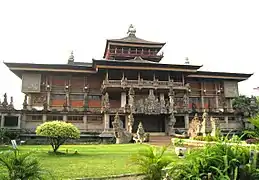
There are fourteen museums at TMII:
- Indonesia Museum
- Purna Bhakti Pertiwi Museum
- Soldier Museum
- Indonesian stamps Museum
- Pusaka (Heirloom) Museum
- Transportation Museum
- Museum Electricity & New Energy Museum
- Telecommunication Museum
- Penerangan Museum
- Sports Museum
- Asmat Museum
- Komodo Indonesian Fauna Museum and Reptile Park
- Insects Museum
- Research & Technology Information Centre
- Oil & Gas Museum
- East Timor Museum (former East Timor province pavilion)
Theatres
- Keong Emas (Golden Snail) Imax Theater
- Tanah Airku Theater
- 4D Theater
Monuments, halls, buildings and other exhibits
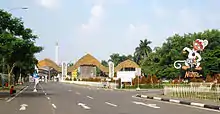
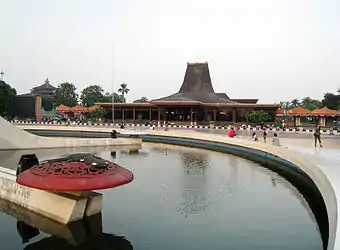
- Kala Makara main gates
- Flower clock
- Tugu Api Pancasila, the main monument, an obelisk celebrating Pancasila
- Baluwerti, a twin gate with relief of Indonesian history on its wall
- Pendopo Agung Sasono Utomo (Grand Hall), the main building in Javanese Joglo style
- Sasono Utomo, exhibition hall
- Sasono Langen Budoyo, indoor stage and theater
- Sasono Manganti
- Sasana Kriya, multi purpose function hall
- Park Management Office
- Cokot Sculpture, a display of wooden sculptures by Cokot, a famous Balinese artist
- The Miniature of Borobudur
- APEC Memorial Monument and Garden
- Non Alignment Nations Friendship Monument and Garden
- The Miniature of Indonesian Archipelago on central lake
- Indonesian Archipelago Plaza and Stage
- Jati Taminah, a remnant of a large teak tree
- Kayu Gede (large wood), the display of large tree trunk
Rides
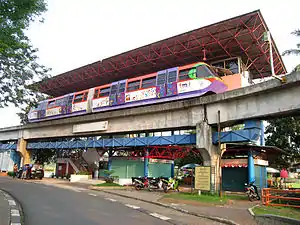
- Skylift Indonesia cable car
- SHS-23 Aeromovel Indonesia, a wind powered people mover
- Mini train around the park (Permanently Closed)
- Boat ride on Indonesian archipelago lake
- Swan paddle boat on Indonesian archipelago lake
- Bicycle rent ride
- Car ride around the area
Recreation facilities

- Istana Anak-Anak Indonesia (Indonesian Children Castle)
- Taman Among Putro kiddy rides park
- Desa Seni dan Kerajinan handicraft center
- Rare books market
- Snowbay Waterpark swimming pool
- Telaga Mina fishing pond
- Warna Alam outbound camp
Lodgings
- Desa Wisata hostel
- Graha Wisata Remaja youth hostel
Restaurants
- Caping Gunung restaurant
- California Fried Chicken restaurants
- Pecel Madiun restaurant
- Various cafetarias and warungs available throughout the park featuring Indonesian cuisines such as soto, gado-gado, nasi goreng and satay.
Plans
As of 2011 the operator planned to disburse $35 million for building a new Discovery World theme park. A 2-hectare area was to be built and it was predicted to be operated before the end of 2012. It would serve 100 venues/rides and was predicted to attract 1.2 million visitors from Indonesia and Southeast Asia.
Gallery
 Tourists take a ride on this cable car to enjoy bird-eye view of this park
Tourists take a ride on this cable car to enjoy bird-eye view of this park
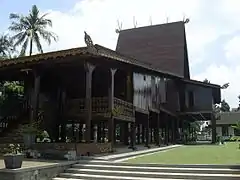 South Kalimantan pavilion in TMII
South Kalimantan pavilion in TMII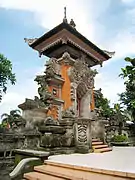 Bali pavilion gate
Bali pavilion gate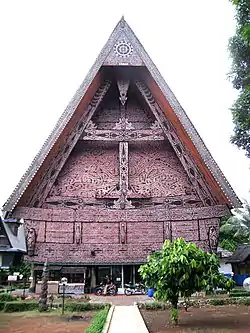 Toba Batak house at North Sumatra pavilion
Toba Batak house at North Sumatra pavilion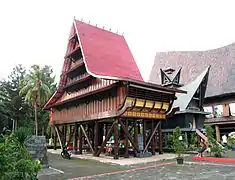 Nias house at North Sumatra pavilion
Nias house at North Sumatra pavilion Baluk house at West Kalimantan pavilion
Baluk house at West Kalimantan pavilion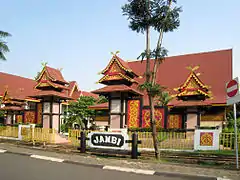 Jambi pavilion
Jambi pavilion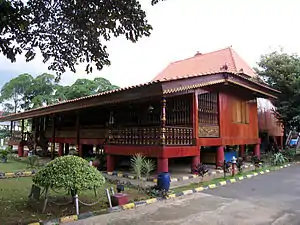 South Sumatra pavilion
South Sumatra pavilion Riau pavilion
Riau pavilion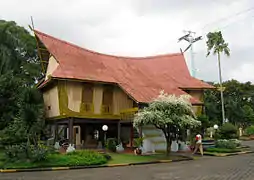 Malay house at Riau pavilion
Malay house at Riau pavilion Aceh pavilion
Aceh pavilion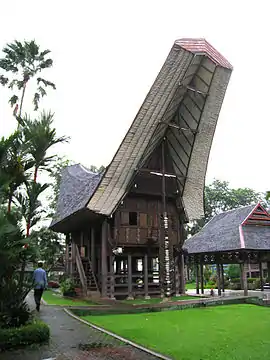 Toraja house, South Sulawesi pavilion
Toraja house, South Sulawesi pavilion Bugis house, South Sulawesi pavilion
Bugis house, South Sulawesi pavilion A joglo at Central Java pavilion
A joglo at Central Java pavilion Interior of Javanese Joglo house, Central Java pavilion
Interior of Javanese Joglo house, Central Java pavilion Kong Miao Confucian temple
Kong Miao Confucian temple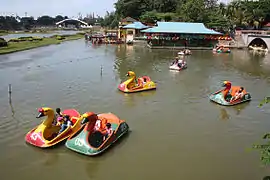 Swan pedalo rides at archipelago lake
Swan pedalo rides at archipelago lake
Sources
- History Archived 2006-09-01 at the Wayback Machine
- "TMII Ditetapkan Sebagai Wahana Perdamaian Dunia". December 31, 2014.
- Anjungan
- "TMII Luncurkan Wahana Robotik". February 1, 2012. Archived from the original on February 2, 2012.
External links
| Wikimedia Commons has media related to Taman Mini Indonesia Indah. |
- (in Indonesian) Official website
